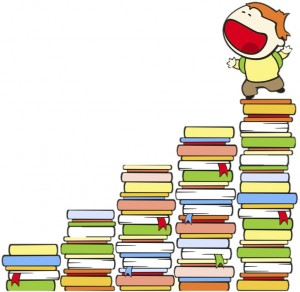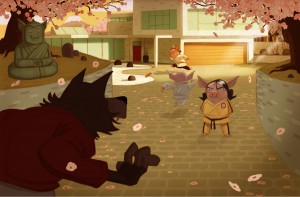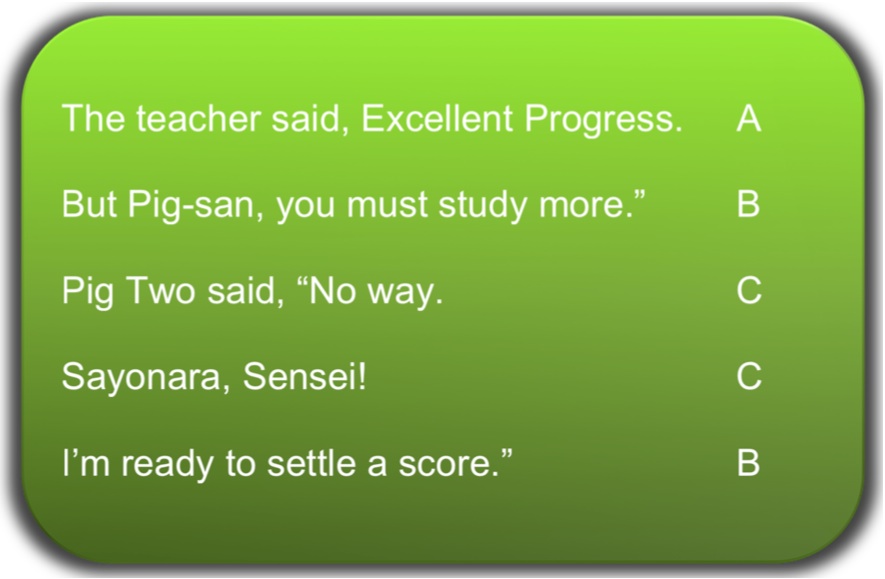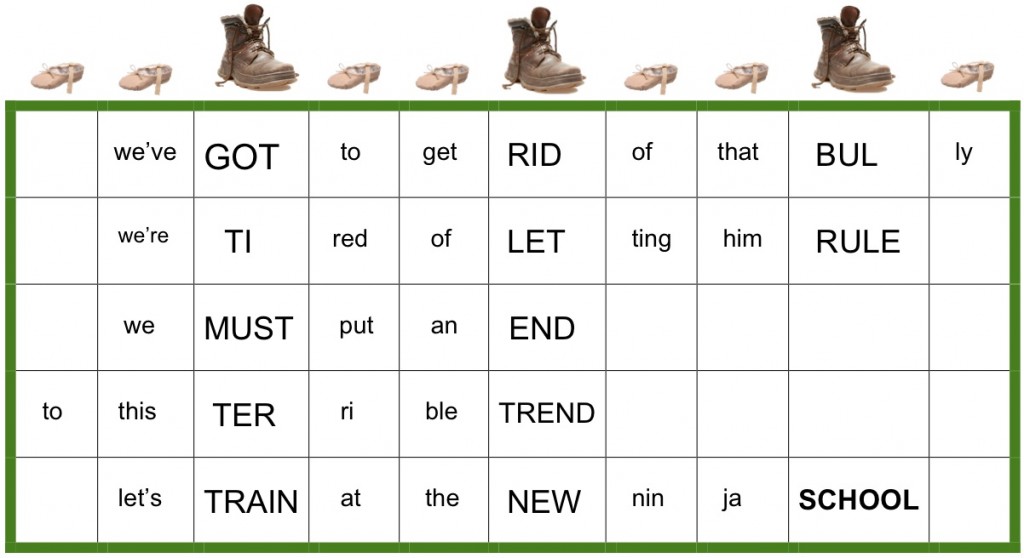This blog breaks down and analyzes the components of one excellent picture book every month. It’s one thing to read about the techniques that make a great children’s story, but in order to really learn what those techniques are– it’s best to see them in action. If you want to be notified when a new analysis comes out, make sure and subscribe to this feature on the right. I hate both advertising and junk mail so your email won’t be used for any other purpose. Below I look at
1) The elements that make this book a great story.
2) The type of meter used and its metrical variations.
3) The rhyme scheme and types of rhymes used.

STORY/PLOT: The 3 Ninja Pigs is a retelling. The main advantage of a retelling is that the plot is already worked out for you. It’s been tested and found worthy of human enjoyment. And plot is probably the most important part of a story. The disadvantage of a retelling, is that you have to come up with some clever twist that no one else has thought of. Not an easy task. No publisher is going to come up with big cash to produce the SAME OLD SAME OLD. But in the case of The 3 Ninja Pigs, Corey Rosen Schwartz has come up with an awesome and marketable twist: the pigs are Ninjas. And they don’t build houses, they take martial arts lessons. Think about how many kids take martial arts lessons. Yeah, a lot. So, brilliant choice. Also her execution is flawless. So lets look at it.
If you’re not familiar with the traditional plot, see section 303 The Traditional Plot under the STORY tab on the navigation menu.
 CHARACTER: The characters are pigs. They have to be; it’s in the title. Generally, a picture book only has one or two main characters, but these pigs aren’t truly differentiated characters. Like the three bears or the three men in a tub, only one characteristic distinguishes them from one another and that characteristic is relevant to the theme. Besides these aren’t just pigs out who seek their fortune (whatever that means) they’re NINJA pigs. Way cooler.
CHARACTER: The characters are pigs. They have to be; it’s in the title. Generally, a picture book only has one or two main characters, but these pigs aren’t truly differentiated characters. Like the three bears or the three men in a tub, only one characteristic distinguishes them from one another and that characteristic is relevant to the theme. Besides these aren’t just pigs out who seek their fortune (whatever that means) they’re NINJA pigs. Way cooler.
CONFLICT: Conflict is essential in a plot. Sometimes this is called the Problem. There must be some tension, some problem that the character must struggle against. In this story, it’s the wolf. Even kids who have never seen one know that a wolf is a problem. Rosen Schwartz has written a pretty traditional wolf. He, too, is a  ninja. And it’s good to ask yourself if that was the best choice. She could have made him and eggplant or some ferocious animal other than a wolf. But how would that have worked? There might be a good retelling where the wolf isn’t the wolf, but in this retelling, I like him as a ninja wolf. The thing I like best about him is that he still huffs and puffs. Perhaps wolves don’t have to huff and puff in 3 Little Pig retellings, but I personally like it when they do. They probably don’t in other languages where huffing doesn’t rhyme with puffing. But this is a kids story and we like rhymes. I was extremely glad to see “the hair of my chinny chin chin.” In my opinion, these were all great choices, an excellent balance of the traditional and the twist with one more important choice. On page three, a pig says, “We’ve got to get rid of that bully.” And in that one line, the wolf becomes part of every kid’s world and he matters in a way that he might not have if he was just a wolf and not a wolf/bully. In retrospect these might seem like easy choices, but remember that next time you sit down to write a story. If the choices look obvious after the fact, they were great choices, but they probably weren’t easy.
ninja. And it’s good to ask yourself if that was the best choice. She could have made him and eggplant or some ferocious animal other than a wolf. But how would that have worked? There might be a good retelling where the wolf isn’t the wolf, but in this retelling, I like him as a ninja wolf. The thing I like best about him is that he still huffs and puffs. Perhaps wolves don’t have to huff and puff in 3 Little Pig retellings, but I personally like it when they do. They probably don’t in other languages where huffing doesn’t rhyme with puffing. But this is a kids story and we like rhymes. I was extremely glad to see “the hair of my chinny chin chin.” In my opinion, these were all great choices, an excellent balance of the traditional and the twist with one more important choice. On page three, a pig says, “We’ve got to get rid of that bully.” And in that one line, the wolf becomes part of every kid’s world and he matters in a way that he might not have if he was just a wolf and not a wolf/bully. In retrospect these might seem like easy choices, but remember that next time you sit down to write a story. If the choices look obvious after the fact, they were great choices, but they probably weren’t easy.
INTERNAL CONFLICT: Not all stories have an Internal Conflict, but it adds a layer of complexity to a story. An Internal Conflict is like a character flaw, an issue INSIDE the main character that he or she needs to overcome. The Internal Conflict is the same as it is in the traditional story, but with the same snazzy twist: The characters are lazy, they lack commitment. In really good writing, the External Conflict should bring about a forced confrontation of the Internal Conflict. Let’s see how this story handles it.
 RISING ACTION: While this might seem like the easy part of the story, this is where Rosen Schwartz has done her best work. As readers we need to see the pigs’ commitment in three different levels, but we also need to see the tension rise. In the original story, the pIgs build houses, but in this story they take martial arts classes in order to stand up to the wolf/bully. See how the bully feature meshes seamlessly with Rosen Schwartz choice of rising action and theme? See how the external conflict (the wolf/bully) forces the character to acknowledge his Internal Conflict. Excellent story telling. The first pig takes akaido and gives up after a few lessons. How man parents have had to deal with that scenario? So Rosen Schwartz choice of action also resonates with modern parents. Modern six-year-olds don’t really understand the complexities of comparative building materials in creating structural soundness in personal dwellings. Okay, so I made that sentence really abstract to make a point. Kids don’t know if their house is built of straw or sticks or silly putty, but they do know their parents don’t like them to quit something after a few lessons. In the story, the first two pigs get cocky and quit early only to get their butts kicked by the wolf/bully. But the third pig sticks with his lesson and scares the bully off with her mad skillz. She worked harder. The lesson is perseverance. The moral of the story is that hard work pays off.
RISING ACTION: While this might seem like the easy part of the story, this is where Rosen Schwartz has done her best work. As readers we need to see the pigs’ commitment in three different levels, but we also need to see the tension rise. In the original story, the pIgs build houses, but in this story they take martial arts classes in order to stand up to the wolf/bully. See how the bully feature meshes seamlessly with Rosen Schwartz choice of rising action and theme? See how the external conflict (the wolf/bully) forces the character to acknowledge his Internal Conflict. Excellent story telling. The first pig takes akaido and gives up after a few lessons. How man parents have had to deal with that scenario? So Rosen Schwartz choice of action also resonates with modern parents. Modern six-year-olds don’t really understand the complexities of comparative building materials in creating structural soundness in personal dwellings. Okay, so I made that sentence really abstract to make a point. Kids don’t know if their house is built of straw or sticks or silly putty, but they do know their parents don’t like them to quit something after a few lessons. In the story, the first two pigs get cocky and quit early only to get their butts kicked by the wolf/bully. But the third pig sticks with his lesson and scares the bully off with her mad skillz. She worked harder. The lesson is perseverance. The moral of the story is that hard work pays off.
CLIMAX: This is another section where Rosen Schwartz shines. As previously stated, the  average modern six-year-old will never encounter a wolf at this door and he will never build a house, but he will likely encounter a bully, and the third pig comes face to face with the Wolf/bully after both of her brothers have been shown up. The pressure is on, because there’s nowhere left to run. The third pig doesn’t actually fight the wolf, she shows off a little and scares him away. Isn’t that how it works most of the time? Sure, kids get beat up, but no one wants to read or even think about that. And nobody really actually wants their kid to beat up another kid, either. We want our kids to stand up for themselves. We want them to have confidence in themselves and know what is right and wrong.
average modern six-year-old will never encounter a wolf at this door and he will never build a house, but he will likely encounter a bully, and the third pig comes face to face with the Wolf/bully after both of her brothers have been shown up. The pressure is on, because there’s nowhere left to run. The third pig doesn’t actually fight the wolf, she shows off a little and scares him away. Isn’t that how it works most of the time? Sure, kids get beat up, but no one wants to read or even think about that. And nobody really actually wants their kid to beat up another kid, either. We want our kids to stand up for themselves. We want them to have confidence in themselves and know what is right and wrong.
RESOLUTION: The resolution points out the theme and does it really well. Perseverence is worth strivig for. Hard work pays off. And it’s not just relevant to karate, so parents can use this success theme for soccer and math and piano. A kid can see from this story without even realizing it that perfecting any art has a positive consequence. There’s even a reality that underlies this: Kids with confidence are not bullied as often as kids who lack confidence. And while it may seem like a stretch–it isn’t: If you work hard at something and become someone with confidence, you are less likely to be bullied.
THEMES: I’ve covered this above so I won’t belabor the themes, but notice that these themes are all developmentally relevant for children in the age range of the book. Bullying. Perseverance. Hard work. Martial arts.
For more on this read 301 Themes under STORY on the navigation bar.
RHYME SCHEME: ABCCB
The Rhyme Scheme is ABCCB because lines 2 and 5 rhyme (hence the same letter designator B) and because lines 3 and 4 rhyme (hence the same letter designator C). Line 1 is designated as the letter A, and since there are no other letters designated as A, we are safe to assume that there is no rhyme for this line. And if you look at the graphic above, there is no rhyme for the last word of line A [progress]. In the grid below, you can see that this is also the case–none of the end words rhyme with [bully]. For more on Rhyme Schemes see 203 Rhyme Schemes under RHYME on the navigation menu. And for an alternate interpretation of how this Rhyme Scheme could be laid out, see 207 Internal Rhymes also under RHYME in the navigation bar.
INTERNAL RHYMES STRUCTURED: for a discussion of how this story can be viewed with an internal rhyme structure see 207 Internal Rhymes under RHYME on the navigation bar.
STANZA & BEAT COUNT: 3/3/2/2/3
METER: Anapestic Trimeter and Dimeter
While the base meter is Anapestic, there are two different line lengths. If you look at the beat count above, it is 3/3/2/2/3. Beats is just another word for STRESSED syllables. What this Beat Count tells you is that the first, second and fifth lines (also shown in the grid below) all have 3 STRESSED syllables, Trimeter. Lines three and four have only 2 STRESSED syllables, Dimeter. By using two different line lengths in her stanzas, Rosen Schwartz keeps the rhythm interesting. It’s a good technique, one any rhyme writer should be aware of as an option. Be careful if you decide to count out the beats in this book because the very first line in the story actually has 4 beats, but it is the only one that does. Also, notice what a great line it is:
ONCE up ON a DAN ger ous TIME
For more on how line lengths are named see 104A Metrical Lines and 104B Important Meters under the METER tab in the navigation bar.
If you look at the grid below, notice that Rosen Schwartz has devised an original format for her Stanzas. And here is what I mean by that: Instead of every single line being exactly anapestic Dimeter or Trimeter, the first beat of lines 123 and 5 are headless, so there is only that one UNstressed syllable in the first beat instead of the two that usually make up anapestic meters. Headless lines are a good way to break up a continuous meter. Also notice that the first line in the stanza has a single hypercatalectic syllable at the end. Normally an anapestic meter ends on a STRESSED syllable, but in this story, most of the stanzas include an extra syllable on the first line. Not every one does, but it is frequent enough that we can assume this extra syllable is there by DESIGN, the same way that the headless initial beats are there by DESIGN. Anyone can design a specific structure for their stanzas and this is an excellent example of how Meter can be customized and still be perfect.
For more on what makes a meter perfect, see 103 Metrical Feet, 105A Metrical Variance, and 105B Mixed Meter under METER in the navigation bar at the top of the page.

SLANT RHYMES: 2
Off syllable: No way/Sensei, nonstop/pork chop
Initial Sound: 0
End Sound: 0
Plural/Singular: 0
Past/Present tense: 0
For more on what constitutes a slant rhyme see 204 Slant Rhymes and 206 On Plurals under the RHYME tab in the navigation menu.
KILLER RHYMES: BELOW IS A LIST OF SOME OF THE REALLY AWSOME RHYMES IN THIS STORY.
Shaken/bacon
Nonstop/pork chop
Techniques/ weeks
No way/Sensei
Hut/butt (what kid doesn’t want a story with the word butt in it?)
In/ chinny chin chin (I love that chinny chin chin made the text.)
Lodged/dodged
Weapon/steppin’
Huffing/bluffing
Ham/scram
Mojo/dojo
